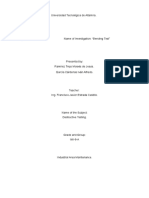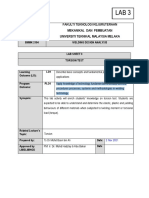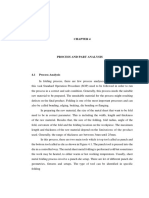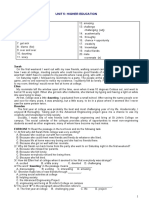TorsionTest Lab Report
TorsionTest Lab Report
Uploaded by
Pranksterz StarzCopyright:
Available Formats
TorsionTest Lab Report
TorsionTest Lab Report
Uploaded by
Pranksterz StarzOriginal Description:
Copyright
Available Formats
Share this document
Did you find this document useful?
Is this content inappropriate?
Copyright:
Available Formats
TorsionTest Lab Report
TorsionTest Lab Report
Uploaded by
Pranksterz StarzCopyright:
Available Formats
Torsion Test : Lab Report
Task:
The purpose of this experiment is using a Torsion Tester we set out to find the Modulus
of Rigidity or Shear Modulus of the specimen being tested.
Specimen:
The specimen being tested today is a 6.!mm or " inch metal rod approximately #$%mm
long.
&'uipment:
The e'uipment being used for the test is a Torsion Tester( it has one fixed end that is
holding the metal rod with a grub screw and does not rotate .The other end is fixed with a
grubbing also but is free spinning with a pulley. )t has string wound onto the pulley in the
opposite direction that the tor'ue is going to be applied ( it also has a platform*carriage
that is to house the weights that will be added with each measurement. The pulley end of
the e'uipment also has a 6% degree readout that is to measure the difference in angle as
the different weights that are applied( this readout measures in degree increments.
+rocedure:
,- Measure diameter and length of rod( radius of pulley( mass and any other rele.ant
data. Then we need to reset the angle.
$- /dd mass and measure angle.
- Repeat step $ until enough measurements are taken to draw a graph.
Results:
Mass
(kg)
Angle in
degrees
Angle in
radians
Force
(N)
1.1 7 0.122 10.791
2.1 13 0.227 20.601
3.1 19 0.332 30.411
4.1 25 0.436 40.221
5.1 30 0.524 50.031
Shear Modulus of ,0.$ 1+a was calculated.
+ublished Shear Modulus is 2% 1+a
3onclusions:
)t was noticed that after the first , kg weight was applied totaling ,., kg including the
weight of the platform*carriage at %., kg( the angular reading taken was # degrees( the
next three times , kg weights were added and angular readings were taken( The angle had
increased by 6 degrees with each weight increment. The final time weight was added it
brought the total weight up to !., kg( The last angular increment 6 degrees bringing all
the weight to a total angle of % degrees. / conclusion made is that we probably didn4t
take enough measurement as we should ha.e( approximately $% measurements should
ha.e probably been taken for a more accurate experiment.
&rrors:
The first error to be noted is the resolution or limitation of precision of the 6%
degree readout that we ha.e on the Torsion tester( it is measuring in whole degree
increments( Therefore we could ha.e a M+& of one degree di.ided by $ or simply
half a degree.
There has also been rounding off with some of the calculations and or figures
recorded which can also bring slight inaccuracy.
There could ha.e been better precision with measuring the o.erall length of the
metal rod being tested.
/bsolute error 5 6%.%$##mm7 8 6%.!mm7 5 8*- %.!$##mm
Relati.e error 5 %.!$##*,.669 5 %.%,666 or %,.666:
You might also like
- Impact Test Lab ReportDocument21 pagesImpact Test Lab Reporttariqlewis07No ratings yet
- In-Course Assessment (Ica) SpecificationDocument21 pagesIn-Course Assessment (Ica) Specificationmohsin ali0% (1)
- AM1.6 - Mechanical Testing (Tensile)Document6 pagesAM1.6 - Mechanical Testing (Tensile)Flying ThinNo ratings yet
- Torsion ReportDocument14 pagesTorsion ReportEric DuncanNo ratings yet
- Torsion Testing ExperimentDocument11 pagesTorsion Testing ExperimentAnoj pahathkumburaNo ratings yet
- Bending Test.Document21 pagesBending Test.julio padronNo ratings yet
- Lab 4-TORSION TEST PDFDocument6 pagesLab 4-TORSION TEST PDFJesse Lee0% (3)
- 2020 - PFRS For SEs NotesDocument16 pages2020 - PFRS For SEs NotesRodelLabor100% (1)
- Quiz 1 - Business CombiDocument6 pagesQuiz 1 - Business CombiKaguraNo ratings yet
- Lab3 Torsion TestDocument16 pagesLab3 Torsion TestAlif EmirNo ratings yet
- Davits ReportDocument21 pagesDavits ReportJoshua ReynoldsNo ratings yet
- Pure Bending in BeamDocument24 pagesPure Bending in Beamasyraaf md diwiNo ratings yet
- Torsion Test Lab Report PDFDocument40 pagesTorsion Test Lab Report PDFengkuNo ratings yet
- Charpy Impact TestDocument2 pagesCharpy Impact TestGanim Shed100% (1)
- Mechanics of Materials - Column Buckling TestDocument13 pagesMechanics of Materials - Column Buckling TestDavid Clark93% (14)
- Torsion LabDocument22 pagesTorsion LabNeoXana01No ratings yet
- Experiment N 6Document3 pagesExperiment N 6G. Dancer Gh100% (1)
- Report Lab Sheet MetalDocument12 pagesReport Lab Sheet MetalMUHAMMAD DANISH HAZIQ AMIRULL FAKARUDDINNo ratings yet
- Ch.3 Support Reactions of BeamsDocument5 pagesCh.3 Support Reactions of BeamsUmesh ShindeNo ratings yet
- EXP 5 TorsionDocument18 pagesEXP 5 TorsionYagami KirigayaNo ratings yet
- Report LabDocument3 pagesReport LabAmirul AriffNo ratings yet
- Lab Report Structual Analysis ArchDocument4 pagesLab Report Structual Analysis ArchChoo Fu-KiatNo ratings yet
- Experiment 3: Strut BucklingDocument8 pagesExperiment 3: Strut BucklingEdmund TiewNo ratings yet
- CEWB21 Exp 4 Full ReportDocument9 pagesCEWB21 Exp 4 Full ReportNur FarehaNo ratings yet
- LAB REPORT 2-HINGED ARCH (Reference)Document11 pagesLAB REPORT 2-HINGED ARCH (Reference)jajenNo ratings yet
- The Effect of Current On SMAW Welding To Tensile Strength and Micro Structure of Low Carbon SteelDocument5 pagesThe Effect of Current On SMAW Welding To Tensile Strength and Micro Structure of Low Carbon Steelmade dwi payanaNo ratings yet
- Effect of The Use of Ceramic Filters in Steel CastingDocument6 pagesEffect of The Use of Ceramic Filters in Steel CastingBrijesh YadavNo ratings yet
- Torsion TestDocument16 pagesTorsion TestEmaan W KaNo ratings yet
- Lab Sheet 2 - Microstructure Study of Ferrous and Non Ferrous - StudentDocument2 pagesLab Sheet 2 - Microstructure Study of Ferrous and Non Ferrous - StudentimfendiNo ratings yet
- Tensile Test Lab 1Document30 pagesTensile Test Lab 1hanser100% (1)
- Formal Lab Report - Work and EnergyDocument4 pagesFormal Lab Report - Work and Energyapi-270086937No ratings yet
- Final Lab 3 M2 EMD4M6B PDFDocument50 pagesFinal Lab 3 M2 EMD4M6B PDFFirdaus MikeNo ratings yet
- Lab Report ArchDocument22 pagesLab Report ArchjajenNo ratings yet
- DJJ30113 LAB SHEET LAB 3 Vickers Hardness TestDocument6 pagesDJJ30113 LAB SHEET LAB 3 Vickers Hardness TestArif DanialNo ratings yet
- Torsion TestDocument4 pagesTorsion TestankitsuchantiNo ratings yet
- Proposal Mec435Document12 pagesProposal Mec435Mohd Sayyid Mu'ammarNo ratings yet
- Lab # 6 Tensile TestingDocument4 pagesLab # 6 Tensile TestinghaimantiNo ratings yet
- MEC424 Content TorsionDocument12 pagesMEC424 Content TorsionHaFiy HaZimNo ratings yet
- Strength of Materials CH 1Document27 pagesStrength of Materials CH 1Aizrul ShahNo ratings yet
- Tensile Test Lab ReportDocument13 pagesTensile Test Lab Reportahmad adnanNo ratings yet
- Impact TestDocument4 pagesImpact TestKumar SamreshNo ratings yet
- Lab Manual - Engg MtlsDocument20 pagesLab Manual - Engg Mtlsiamback09No ratings yet
- Beam Bending Lab ReportDocument22 pagesBeam Bending Lab Reportimlioh_ih50% (2)
- Lab 1 Strength MEC424Document27 pagesLab 1 Strength MEC424doremon100% (1)
- Impact Toughness of Metallic Materials Lab ReportDocument5 pagesImpact Toughness of Metallic Materials Lab ReportEmıły WınıfredNo ratings yet
- Uniaxial TestDocument6 pagesUniaxial Testanil chejaraNo ratings yet
- 13 - Belt Friction Data PDFDocument10 pages13 - Belt Friction Data PDFMuhamad Amirul Amin AminnudinNo ratings yet
- Lab 321 #1 VVVDocument12 pagesLab 321 #1 VVVSamNo ratings yet
- Jominy TestDocument5 pagesJominy TestAhmet Ozan Basar100% (1)
- Coefficient of Friction Lab Write UpDocument5 pagesCoefficient of Friction Lab Write UpPOH HSIN TANNo ratings yet
- OBJ + CONCLUSION BeltDocument1 pageOBJ + CONCLUSION BeltFattihiEkhmalNo ratings yet
- TorsionDocument12 pagesTorsionredz00No ratings yet
- Lab Report 4Document3 pagesLab Report 4Hassan MehmoodNo ratings yet
- Unit V ArchesDocument22 pagesUnit V ArchesPrem KumarNo ratings yet
- Tensile Test LabDocument4 pagesTensile Test LabputrosigarhidayatNo ratings yet
- Metal Forming Chapter 4 and ConclusionDocument4 pagesMetal Forming Chapter 4 and ConclusionNo NameNo ratings yet
- Lab ReportDocument7 pagesLab ReportSrinivas Duvvuri100% (1)
- Fatigue TesDocument3 pagesFatigue Tesvaibhavaher88100% (1)
- HR_Report_millingDocument14 pagesHR_Report_millingoceetera.002No ratings yet
- Physics Elasticity Laboratory ReportDocument7 pagesPhysics Elasticity Laboratory ReportRonnie SolomonNo ratings yet
- Lab 2 Moment of InertiaDocument10 pagesLab 2 Moment of InertiaChing Wai Yong100% (1)
- A-level Physics Revision: Cheeky Revision ShortcutsFrom EverandA-level Physics Revision: Cheeky Revision ShortcutsRating: 3 out of 5 stars3/5 (10)
- Minutes of Meeting OshaDocument1 pageMinutes of Meeting OshaPranksterz Starz100% (1)
- RPP-BDA10203 Statics Sem1 - 20142015Document5 pagesRPP-BDA10203 Statics Sem1 - 20142015Pranksterz StarzNo ratings yet
- Perincian & PenafianDocument1 pagePerincian & PenafianPranksterz StarzNo ratings yet
- Thin CylinderDocument16 pagesThin CylinderPranksterz StarzNo ratings yet
- Ctms For IcriDocument70 pagesCtms For IcrisomcologyNo ratings yet
- Panel 1 - Brett Walker Roberts - Child Support Agency (English)Document26 pagesPanel 1 - Brett Walker Roberts - Child Support Agency (English)Mustafa KamalNo ratings yet
- Assignment 1 Front SheetDocument14 pagesAssignment 1 Front SheetHiền ThảoNo ratings yet
- Dr. Shiv's ArticleDocument6 pagesDr. Shiv's ArticleIndo-MIMNo ratings yet
- ENISA Report - Remote ID ProofingDocument87 pagesENISA Report - Remote ID ProofingCatalina GeorgianaNo ratings yet
- Compliance Learning ListDocument3 pagesCompliance Learning ListYuvarani K NNo ratings yet
- Bai Tap Unit 5-8Document17 pagesBai Tap Unit 5-8Linh Chi Ngô PhạmNo ratings yet
- Audit ReportDocument2 pagesAudit ReportNgo PartnerNo ratings yet
- Distinguish Between The Study of Microeconomics and MacroeconomicsDocument5 pagesDistinguish Between The Study of Microeconomics and MacroeconomicsDonasco Casinoo ChrisNo ratings yet
- MGT Group Project (1) (PDF)Document22 pagesMGT Group Project (1) (PDF)izyannnzsNo ratings yet
- Human Settlements: Unit II Unit II Unit II Unit II Unit IIDocument8 pagesHuman Settlements: Unit II Unit II Unit II Unit II Unit IITirupathi RajaNo ratings yet
- ATTEN ST-1509 ManualDocument8 pagesATTEN ST-1509 ManualjanekiviNo ratings yet
- Injection Product List HDocument11 pagesInjection Product List Halnikki25kNo ratings yet
- Bba Chapter 4 Pricing Under Various Market ConditionsDocument21 pagesBba Chapter 4 Pricing Under Various Market ConditionsDr-Abu Hasan Sonai SheikhNo ratings yet
- CSE403 Network Security and Cryptography: The Kick Start SessionDocument86 pagesCSE403 Network Security and Cryptography: The Kick Start SessionKevin SarserNo ratings yet
- Media Theories - Mindmap in GCSE Media StudiesDocument1 pageMedia Theories - Mindmap in GCSE Media StudiesellieNo ratings yet
- A Study of The MEd Internship Programme PerceivedDocument15 pagesA Study of The MEd Internship Programme PerceivedAmrit VallahNo ratings yet
- Structural Clay Load-Bearing Wall Tile: Standard Specification ForDocument3 pagesStructural Clay Load-Bearing Wall Tile: Standard Specification Forengr. usamakhanNo ratings yet
- B-GS-PB-PP12-01922-T - Hazop Study ReportDocument1 pageB-GS-PB-PP12-01922-T - Hazop Study Reportmohammad kassarNo ratings yet
- Annual Performance AppraisalDocument17 pagesAnnual Performance Appraisalrose7724No ratings yet
- Special Function Register in 8051Document5 pagesSpecial Function Register in 8051saurabh reddewarNo ratings yet
- Trends in Industrial Gear OilDocument8 pagesTrends in Industrial Gear OilM.Tayyab100% (2)
- City Star December 2021 EditionDocument20 pagesCity Star December 2021 Editioncity star newspaperNo ratings yet
- Timo 2024 Heat Round ListDocument120 pagesTimo 2024 Heat Round ListJohn RamirezNo ratings yet
- Retrofitting Design by ETABSDocument41 pagesRetrofitting Design by ETABSSher Afgan100% (3)
- Evaluation of Training Effectiveness in "Rourkela Steel Plant"Document22 pagesEvaluation of Training Effectiveness in "Rourkela Steel Plant"Sandeep SaNo ratings yet
- LSE Summer School Programme Terms and Conditions and Code of ConductDocument7 pagesLSE Summer School Programme Terms and Conditions and Code of ConductHetty SamosirNo ratings yet
- IIS Lecture 2Document27 pagesIIS Lecture 2Saad Mohamed SaadNo ratings yet





























































































